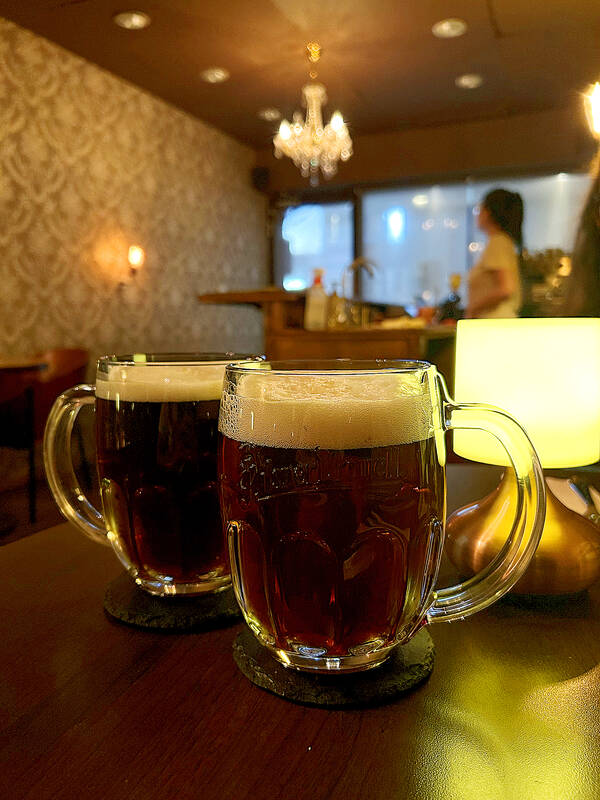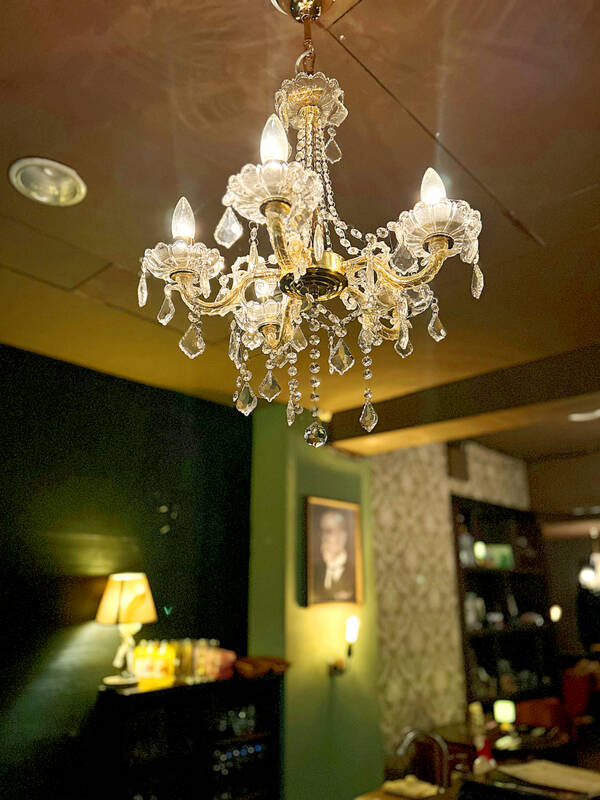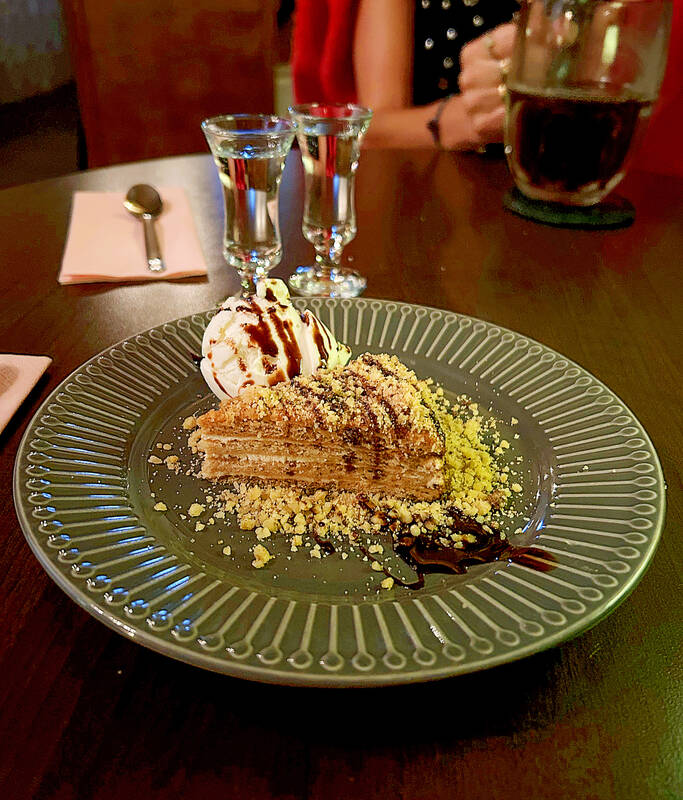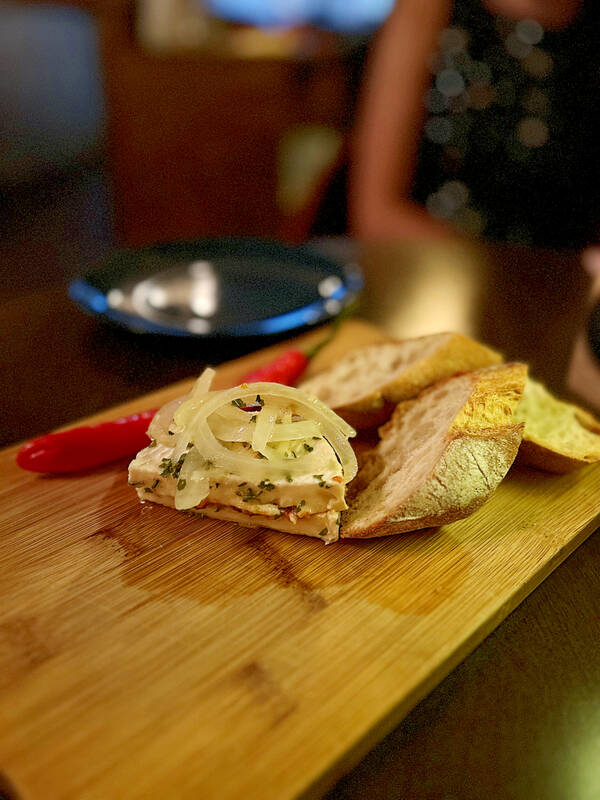Divadlo feels like your warm neighborhood slice of home — even if you’ve only ever spent a few days in Prague, like myself.
A projector is screening retro animations by Czech director Karel Zeman, the shelves are lined with books and vinyl, and the owner will sit with you to share stories over a glass of pear brandy.
The food is also fantastic, not just a new cultural experience but filled with nostalgia, recipes from home and laden with soul-warming carbs, perfect as the weather turns chilly.

Photo: Hollie Younger, Taipei Times
A Prague native, Kaio Picha has been in Taipei for 13 years and opened Divadlo six years ago. I only learned that Czech cuisine was offered in Taipei with its growing social media presence in recent months.
We begin as everyone should, with a proper half-liter stein of beer that requires two hands to drink. Divadlo import kegs of Czech Pilsner from the homeland, and we opt for a Rezany (NT$280), half light beer and half dark beer, to sample the best of both.
For starters, we grab a traditional Czech “beer snack,” the Nakldany Hermelin (NT$220).

Photo: Hollie Younger, Taipei Times
Camembert is marinated in-house with olive oil, herbs and spices, then sandwiched with a paprika-based garlic paste and topped with pickled onions. We slather it on chewy slices of bread from a local German bakery. It reminds us of a cold European Christmas, with tangy hits from the onion and a pickled red chili offering a bit of extra spice.
For the mains, the stand-out signature dish is the Gulas (NT$460).
Perhaps lesser-known than the Hungarian or German goulash, Divadlo’s Czech take is a rich stew packed with chunks of melt-in-the-mouth beef shin, braised for two hours. The sauce is rich, complex and carries a strong meaty flavor using all the juices from the pan, almost reminiscent of a slow-cooked beef curry.

Photo: Hollie Younger, Taipei Times
It’s served with pillowy bread dumplings, similar in texture to a mantou (饅頭) steamed bun, which soaked up the sauce perfectly.
Next up, we try the Kureci Rizek Se Salatem (NT$340), simple but satisfying. A crispy battered chicken cutlet is paired with the real star of the show, Picha’s homemade potato salad.
“My mum wasn’t the best cook,” Picha says, “but her potato salad at Christmas time was the best thing she could make.”

Photo: Hollie Younger, Taipei Times
Using that same original recipe, the cold salad gets its orange color from plenty of carrot and has a strong herby, mustardy dressing. I only wish he sold it to go.
Another popular main is the Svickova (NT$480). Slices of roast beef are paired with a rich, creamy saffron-colored sauce, jam and sour cream and another variation of flour-based dumpling.
The finale to an exceptional meal: home-cooked dessert and a fair slosh of booze.

Photo: Hollie Younger, Taipei Times
A slice of honey cake with a walnut crumb, chocolate sauce and vanilla ice cream wraps up the meal perfectly, sweetened by the fact that this traditional Cesky Medovnik cake (NT$160) is made by an old Czech lady who owns Prague Honey, a bakery in Banqiao (布拉格的調色盤).
Picha then brings over small goblets of pear brandy and plum brandy, Hruskovica (NT$160) and Slivovice (NT$160), respectively, brought back from Czechia by himself and some friends. At 45 proof, they are undeniably strong but not too biting thanks to the fruity notes. A few glasses and several stories shared later, we wobble out with promises to return, as I’m sure many customers end the night here.
The price point is more than reasonable for the generous and filling portions, the imported and unique produce and to help support a small business with such fantastic hospitality.

Photo: Hollie Younger, Taipei Times
Picha’s mother will be coming over for Christmas to try his take on her nostalgic home recipes and taste his potato salad for the first time. But personally, I recommend you get to Divadlo first and try it for yourself.

Seven hundred job applications. One interview. Marco Mascaro arrived in Taiwan last year with a PhD in engineering physics and years of experience at a European research center. He thought his Gold Card would guarantee him a foothold in Taiwan’s job market. “It’s marketed as if Taiwan really needs you,” the 33-year-old Italian says. “The reality is that companies here don’t really need us.” The Employment Gold Card was designed to fix Taiwan’s labor shortage by offering foreign professionals a combined resident visa and open work permit valid for three years. But for many, like Mascaro, the welcome mat ends at the door. A

Last week gave us the droll little comedy of People’s Republic of China’s (PRC) consul general in Osaka posting a threat on X in response to Japanese Prime Minister Sanae Takaichi saying to the Diet that a Chinese attack on Taiwan may be an “existential threat” to Japan. That would allow Japanese Self Defence Forces to respond militarily. The PRC representative then said that if a “filthy neck sticks itself in uninvited, we will cut it off without a moment’s hesitation. Are you prepared for that?” This was widely, and probably deliberately, construed as a threat to behead Takaichi, though it

Nov. 17 to Nov. 23 When Kanori Ino surveyed Taipei’s Indigenous settlements in 1896, he found a culture that was fading. Although there was still a “clear line of distinction” between the Ketagalan people and the neighboring Han settlers that had been arriving over the previous 200 years, the former had largely adopted the customs and language of the latter. “Fortunately, some elders still remember their past customs and language. But if we do not hurry and record them now, future researchers will have nothing left but to weep amid the ruins of Indigenous settlements,” he wrote in the Journal of

If China attacks, will Taiwanese be willing to fight? Analysts of certain types obsess over questions like this, especially military analysts and those with an ax to grind as to whether Taiwan is worth defending, or should be cut loose to appease Beijing. Fellow columnist Michael Turton in “Notes from Central Taiwan: Willing to fight for the homeland” (Nov. 6, page 12) provides a superb analysis of this topic, how it is used and manipulated to political ends and what the underlying data shows. The problem is that most analysis is centered around polling data, which as Turton observes, “many of these